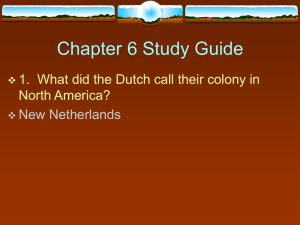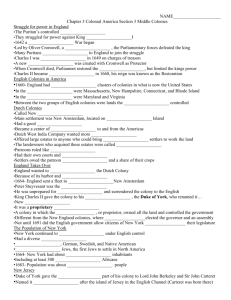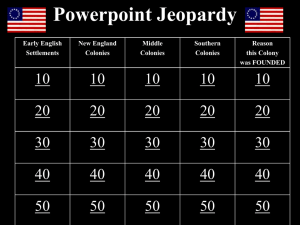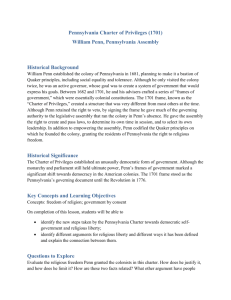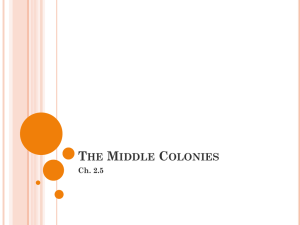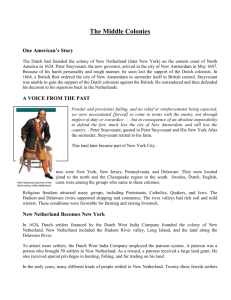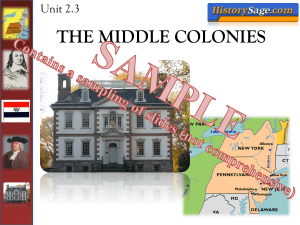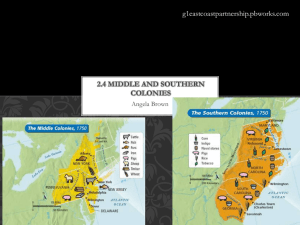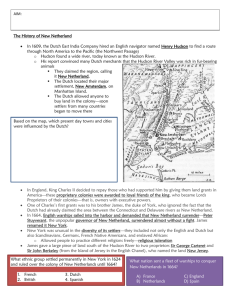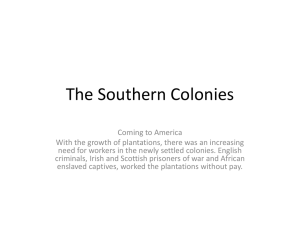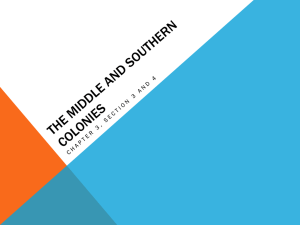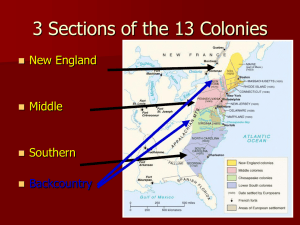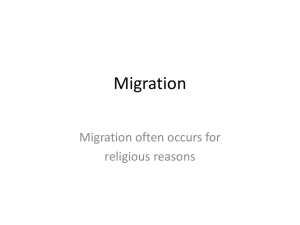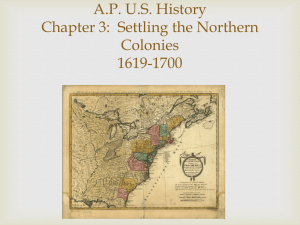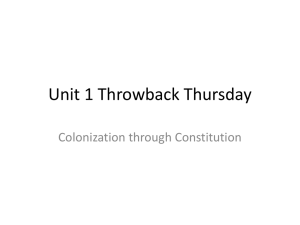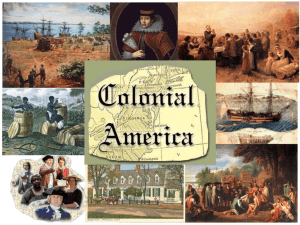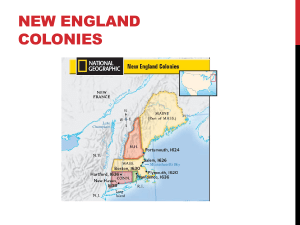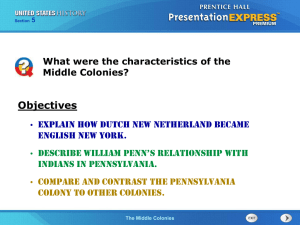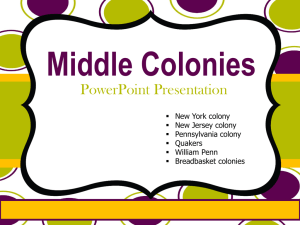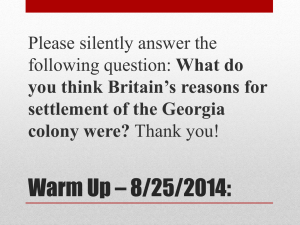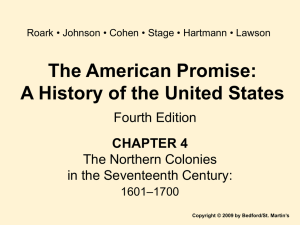ch3s3
advertisement
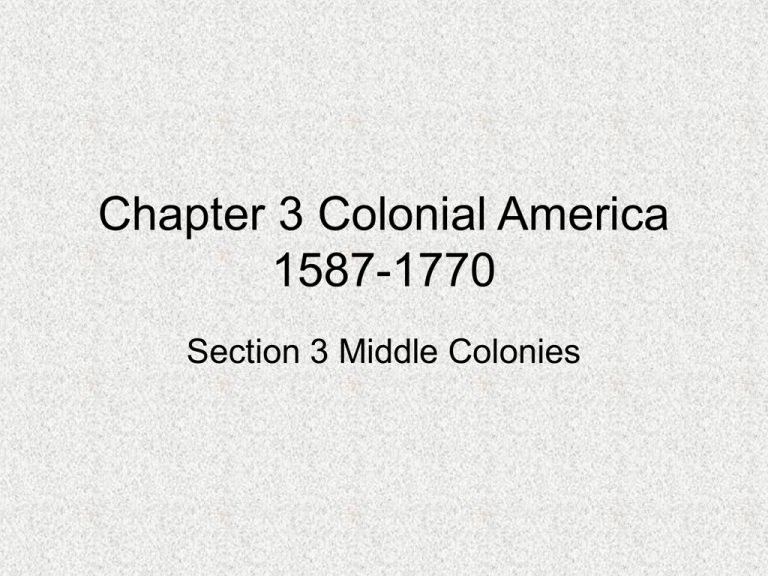
Chapter 3 Colonial America 1587-1770 Section 3 Middle Colonies If you were given the gift of a large sum of money, how likely would you be to share it with your friends and family? A. Very likely B. Somewhat likely C. Somewhat unlikely D. Very unlikely 0% A A. A B. B C. 0% C0% D. D B C 0% D How did the Middle Colonies develop? Struggle for power in England • The Puritan’s controlled Parliament • They struggled for power against King Charles I • 1642 a Civil War began • Led by Oliver Cromwell, a Puritan, the Parliamentary forces defeated the king • Many Puritans returned to England to join the struggle • Charles I was beheaded in 1649 on charges of treason • A new government was created with Cromwell as Protector • When Cromwell died, Parliament restored the monarchy, but limited the kings power • Charles II became king in 1660, his reign was known as the Restoration English Colonies in America • 1660- England had two clusters of colonies in what is now the United States • In the North were Massachusetts, New Hampshire, Connecticut, and Rhode Island • In the South were Maryland and Virginia • Between the two groups of English colonies were lands the Dutch controlled Dutch Colonies • Called New Netherland • Main settlement was New Amsterdam, located on Manhattan Island • Had a good seaport • Became a center of shipping to and from the Americas • Dutch West India Company wanted more settlers • Offered large estates to anyone who could bring 50 settlers to work the land • The landowners who acquired these estates were called patroons • Patroons ruled like kings • Had their own courts and laws • Settlers owed the patroon labor and a share of their crops England Takes Over • England wanted to acquire the Dutch Colony • Because of its harbor and trade • 1664- England sent a fleet to attack New Amsterdam • Peter Stuyvesant was the governor • He was unprepared for battle and surrendered the colony to the English • King Charles II gave the colony to his brother, the Duke of York, who renamed it… • New York • It was a proprietary colony • A colony in which the owner, or proprietor, owned all the land and controlled the government • Different from the New England colonies, where voters elected the governor and an assembly • Not until 1691 did the English government allow citizens of New York elect their legislature The Population of New York • New York continued to prosper under English control • Had a diverse population • Dutch, German, Swedish, and Native American • Brazilian Jews, the first Jews to settle in North America • 1664- New York had about 8,000 inhabitants • Including at least 300 enslaved Africans • 1683- Population was about 12,000 people In which colony did the first Jews settle in America? A. New Jersey B. Virginia C. Maryland D. New York 0% A A. B. C. 0% D. B A B C 0% D C 0% D New Jersey • Duke of York gave the southern part of his colony to Lord John Berkeley and Sir John Carteret • Named it New Jersey after the island of Jersey in the English Channel (Carteret was born there) • To attract settlers, thy offered large areas of land and freedom of religion • Also trial by jury and representative assembly • The Assembly would make the local laws and set tax rates The Population of New Jersey • A place of ethnic and religious diversity • Had no natural harbors so it did not develop a major port or city like New York • The proprietors made few profits • Both proprietors eventually sold their shares in the colony • By 1702 New Jersey had returned to the king, becoming a royal colony • Colonists continued to make local laws Pennsylvania • King Charles II gave land to William Penn to pay off a debt • Named it Pennsylvania and was nearly as large England • Penn saw this as a “holy experiment” • A chance to put his Quaker ideals into practice • The Quakers, or Society of Friends believed that everyone was equal • People could follow their “inner light” to salvation • They did not need a clergy to guide them • Quakers were pacifists, people who refuse to use force or to fight in wars • They were persecuted in England Penn in Pennsylvania • 1682- Penn supervised the building of Philadelphia, the “city of brotherly love” • Penn designed the city and wrote their first constitution • Penn believed the land belonged to the Native Americans and that settlers should pay for it • He negotiated several treaties with local Native Americans Whom did William Penn believe rightfully owned the land where he planned to build Philadelphia? A. The English 0% 0% 0% D 0% A D. The Swedes A B C D C C. The Native Americans A. B. C. D. B B. The Dutch The Population of Pennsylvania • Penn advertised the colony throughout Europe • 1683- There were more than 3,000 English, Welsh, Dutch, and German settlers • 1701, Charter of Liberties allowed colonists to elect representatives to the legislature • Swedes settled southern Pennsylvania • The Charter of Privileges allowed them to form their own legislature • They then functioned, or operated, as a separate colony known as Delaware under Pennsylvania’s governor How did the Middle Colonies develop? New York: Thriving Dutch colony seized by English; major port, proprietary colony; diverse population New Jersey: piece of New York given to other proprietors; land and freedoms offered to attract settlers; diverse population; lacked major port so less profitable; became a royal colony Pennsylvania: established under Quaker ideals; welcomed diverse immigrants; constitution; elected legislature Delaware: lower part of Pennsylvania settled by the Swedes; allowed to function as a separate colony Chapter 3 Section 3 Quiz Which of the following was originally a Dutch colony? New Jersey Rhode Island Philadelphia New York City a Yo rk N ew ila Ph de ho R de l Is la n ph i d y rs e Je ew Ci ty 25% 25% 25% 25% N A. B. C. D. Which of the following was named after an island in the English Channel? Pennsylvania Delaware New Jersey New Amsterdam m y rd a rs e st e Je Am ew N ew N el aw D nn sy l va ni a ar e 25% 25% 25% 25% Pe A. B. C. D. America's first town planner was William Penn. Peter Stuyvesant. Oliver Cromwell. Sir George Carteret. Si rG liv er Ca rt e eo rg e C re t. l. ro m w el an ve s O Pe te r ill ia St uy m Pe nn t. . 25% 25% 25% 25% W A. B. C. D. ia s nn sy Pe of rte r ha C lv an rt ie Li be of rte r ha C nn Pe C ha rte r &# 0 39 of ;s C C ol on ha rt er is ts Which document granted the Pennsylvania colonists the right to elect representatives to the legislative assembly? A. Charter of 25% 25% 25% 25% Colonists B. Penn's Charter C. Charter of Liberties D. Charter of Pennsylvania rn ut he So ar e. D el aw ni a. yl va nn s Pe Am ew N Ph ila st e de l rd a ph i m . a. The Charter of Privileges allowed the lower counties of Pennsylvania to operate as a separate colony known as A. Philadelphia. 25% 25% 25% 25% B. New Amsterdam. C. Southern Pennsylvania. D. Delaware. Participant Scores 0 0 Participant 1 Participant 2 0 0 0 Participant 3 Participant 4 Participant 5 Team Scores 0 0 Team 1 Team 2 0 0 0 Team 3 Team 4 Team 5
